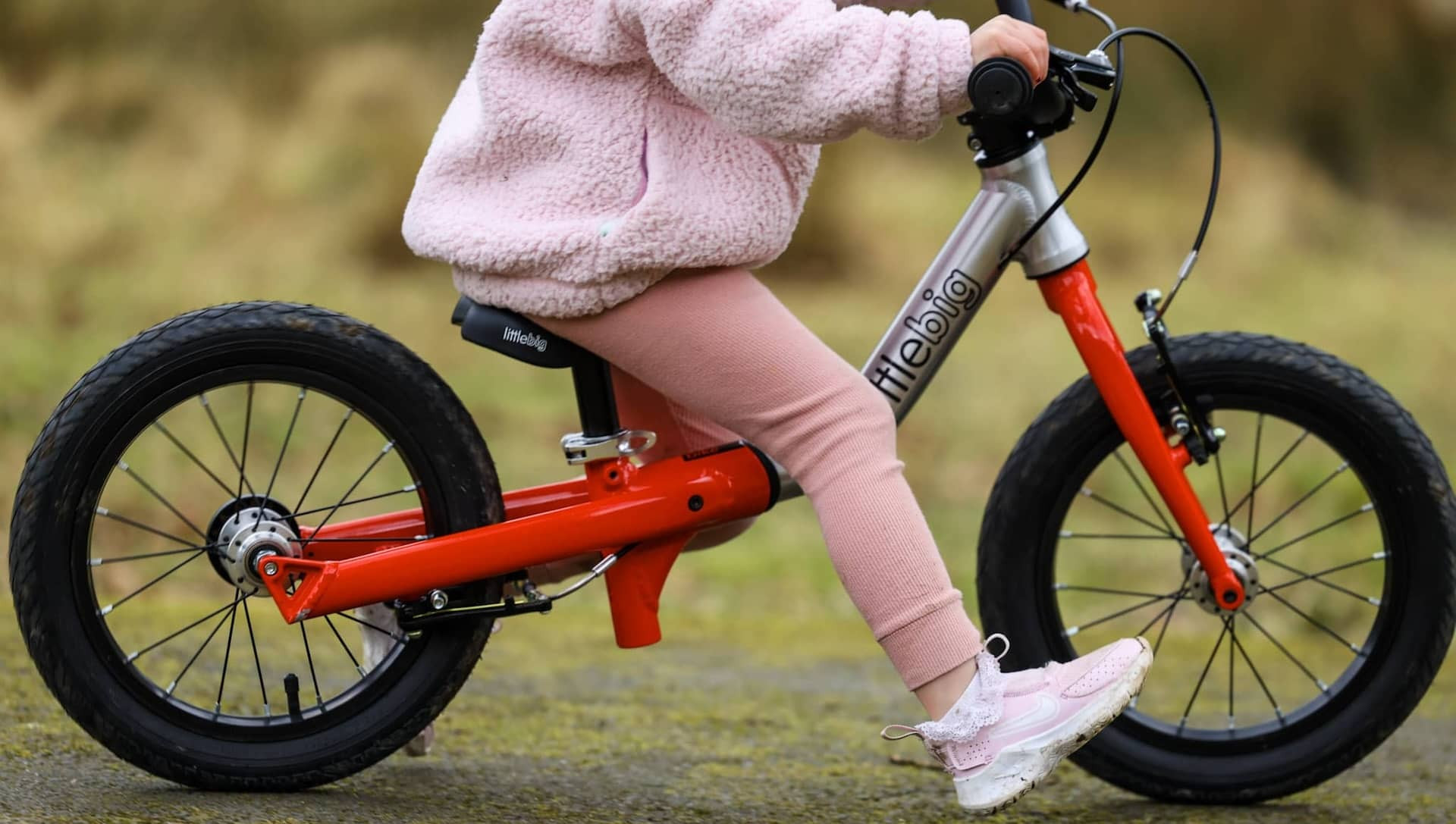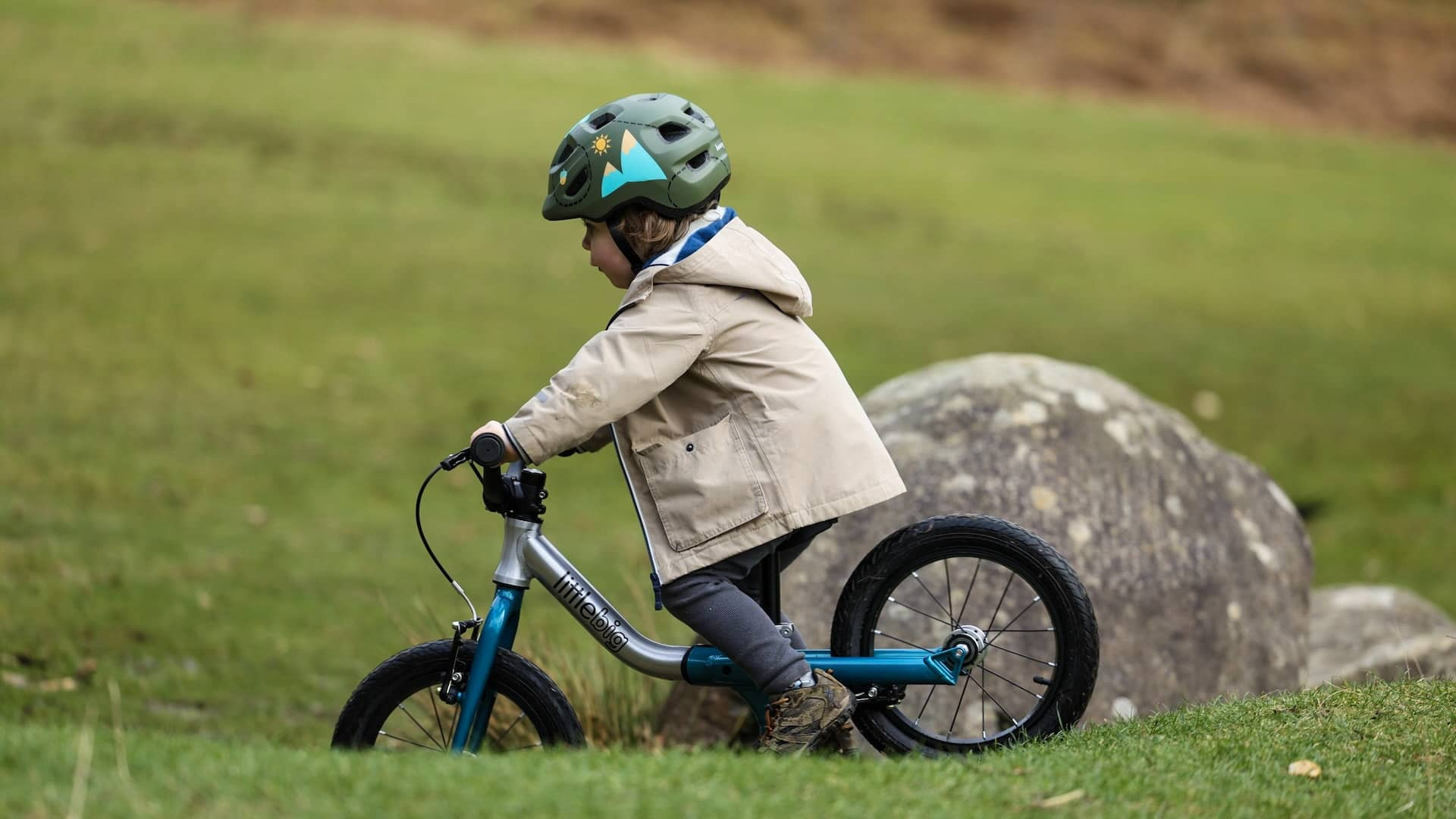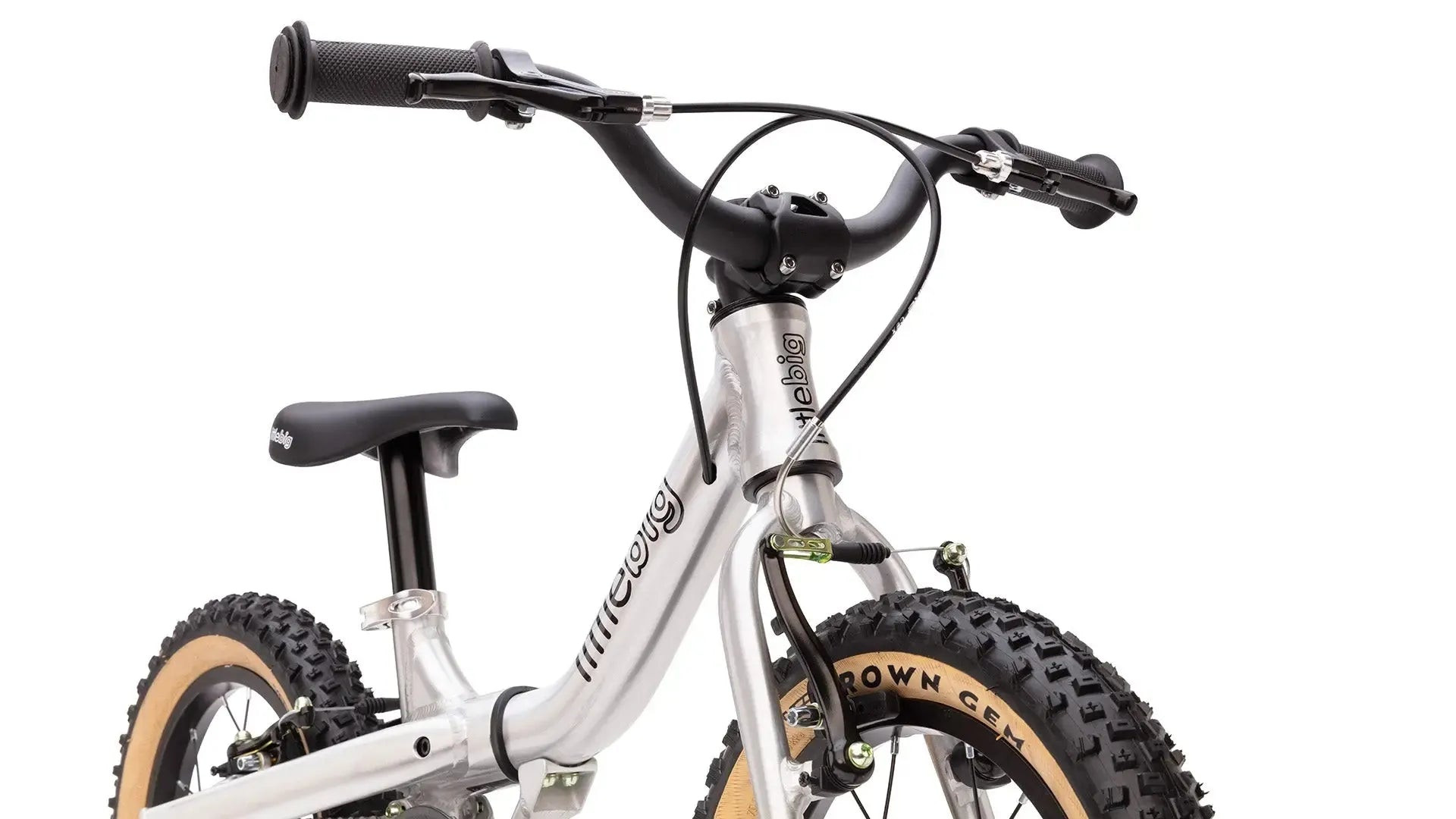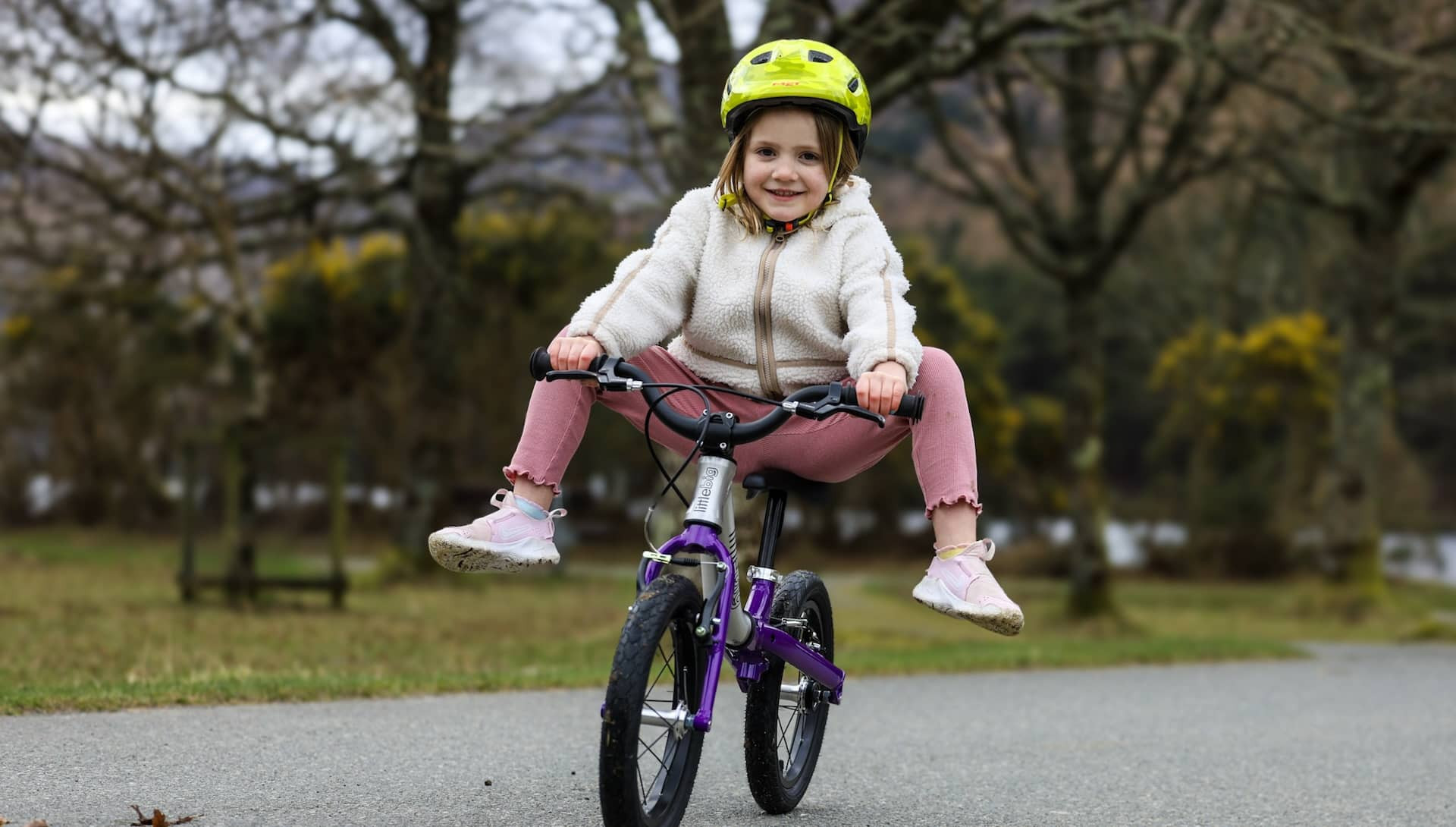Does A Balance Bike Need Brakes? Absolutely, a balance bike can greatly benefit from having brakes, particularly as children gain confidence and start tackling varied terrains. This comprehensive guide from usabikers.net explores the advantages of balance bike brakes and helps you determine the best choice for your young rider’s safety and skill development. We’ll cover everything from choosing the right type of brakes to understanding when your child is ready for them, focusing on safety tips for young children, bike maintenance advice, and the best balance bike features.
1. What Are the Benefits of Having Brakes on a Balance Bike?
Having brakes on a balance bike offers several key advantages, primarily enhancing safety and control for young riders. Brakes enable quicker, easier stops, boost confidence, and cultivate crucial habits for future cycling on traditional bikes.
- Enhanced Safety: Brakes allow children to slow down and stop more effectively, especially on inclines or when moving at higher speeds.
- Increased Control: Brakes give children more control over their speed, helping them manage their balance bike with greater precision.
- Confidence Building: Knowing they can stop reliably helps children feel more confident and secure, encouraging them to explore their abilities.
- Skill Development: Using brakes on a balance bike introduces children to the concept of braking, preparing them for pedal bikes.
- Adaptability: Brakes make balance bikes more adaptable to different terrains, providing better control on both flat surfaces and slopes.
2. At What Age Should a Balance Bike Have Brakes?
The appropriate age for introducing a balance bike with brakes typically falls between two and three years old. By this age, most children have developed the necessary strength and coordination to effectively use hand brakes.
- Under Two Years Old: For very young children (around 18 months), it’s often best to start with a balance bike without brakes. These bikes are lighter, allowing the child to focus on balancing and steering. At this stage, kids usually stop by dragging their feet, which is intuitive and manageable.
- Two to Three Years Old: As children approach two to three years, they develop the coordination needed to use hand brakes. This is an ideal time to introduce a balance bike with brakes, especially if they are gaining confidence and speed.
- Older Than Three Years Old: Children older than three who are already comfortable with a balance bike will benefit greatly from having brakes, particularly if they ride on varied terrain or inclines. Brakes provide the control needed for safe riding at higher speeds.
- Individual Readiness: It’s important to consider each child’s individual development. Some children may be ready for brakes earlier than others, depending on their physical and cognitive abilities. Observe your child’s coordination and confidence to determine the best time to introduce brakes.
3. How Do Brakes on Balance Bikes Improve Safety?
Brakes on balance bikes significantly improve safety by providing children with the means to control their speed and stop effectively, especially in challenging situations. This added control helps prevent accidents and builds confidence.
- Effective Speed Control: Brakes allow children to slow down when approaching obstacles or navigating downhill slopes, reducing the risk of falls.
- Quick Stops: In unexpected situations, such as a sudden obstacle in their path, brakes enable children to stop quickly, preventing collisions.
- Confident Riding: Knowing they can stop reliably gives children the confidence to explore their limits safely, encouraging them to develop their balance and coordination.
- Reduced Risk of Skidding: On certain surfaces, brakes can help children maintain control without skidding, which is especially important when riding on loose gravel or wet pavement.
- Preparation for Pedal Bikes: Learning to use brakes on a balance bike prepares children for the transition to pedal bikes, where braking is an essential skill.
 Girl riding LittleBig balance bike with brakes
Girl riding LittleBig balance bike with brakes
4. What Features Should You Look for When Choosing Brakes for a Balance Bike?
When selecting a balance bike with brakes, several features ensure optimal performance and safety. The material, lever shape, and caliper style are all important factors to consider.
- Material:
- Aluminum: Aluminum is the preferred material for balance bike brakes. It’s strong, lightweight, and resistant to flexing, which provides consistent and reliable braking power. Avoid plastic brakes, as they can flex and break easily, reducing braking efficiency.
- Lever Shape:
- Short Reach Levers: Look for brake levers designed specifically for small hands. These levers are positioned closer to the handlebar grip, making them easier for children to reach and use. Adult brake levers adjusted to a short reach may not be ideal, as they might still be too large for young riders.
- Caliper Style:
- V-Brakes: V-brakes are a popular choice for balance bikes due to their reliability and stopping power. They consist of two straight arms that pivot below the rim, providing excellent braking force. V-brakes may require occasional adjustment to ensure they don’t rub against the rim.
- Sidepull Brakes: While less common, sidepull brakes can also be used on balance bikes. However, V-brakes are generally more powerful and reliable.
- Adjustability:
- Adjustable Levers: Opt for brake levers that can be adjusted to suit your child’s hand size. This ensures they can comfortably and effectively use the brakes.
- Cable Quality:
- Smooth Cables: Ensure the brake cables are of good quality and move smoothly. Stiff or আটকে থাকা cables can make it difficult for children to apply the brakes.
5. Front and Rear Brakes vs. Rear Brake Only: Which Is Better for Balance Bikes?
Deciding between front and rear brakes or a rear brake only depends on your child’s age, skill level, and the terrain they will be riding on. Both options have their advantages and disadvantages.
- Rear Brake Only:
- Pros:
- Simplicity: A rear brake is easier for young children to understand and use, as they only need to focus on one lever.
- Weight: Balance bikes with only a rear brake are often lighter, making them easier for smaller children to handle.
- Cons:
- Limited Stopping Power: A rear brake alone may not provide sufficient stopping power, especially on steep inclines or at higher speeds.
- Skidding: Over-reliance on the rear brake can lead to skidding, which can be dangerous on certain surfaces.
- Pros:
- Front and Rear Brakes:
- Pros:
- Increased Stopping Power: Having both front and rear brakes provides maximum stopping power, allowing children to slow down and stop more quickly and safely.
- Better Control: Using both brakes helps children develop better control over their speed and balance, especially when navigating varied terrain.
- Preparation for Pedal Bikes: Learning to use both front and rear brakes prepares children for pedal bikes, which typically have both.
- Cons:
- Complexity: Coordinating both brakes can be more challenging for very young children.
- Risk of Over-Braking: Children may need to learn how to modulate the front brake to avoid going over the handlebars, although this is less of a concern with balance bikes due to their low center of gravity.
- Pros:
 Boy age 3 going downhill on LittleBig bike
Boy age 3 going downhill on LittleBig bike
6. How Can You Teach a Child to Use Brakes on a Balance Bike?
Teaching a child to use brakes on a balance bike requires patience and a step-by-step approach. Start with the basics and gradually increase the complexity as they gain confidence.
- Start with the Basics:
- Introduce the Levers: Begin by showing your child the brake levers and explaining how they work. Let them practice squeezing the levers while the bike is stationary so they get a feel for the pressure required.
- Practice in a Safe Environment:
- Flat, Open Space: Choose a flat, open area away from traffic and obstacles for initial practice sessions.
- Walking Practice: Have your child walk alongside the bike while squeezing the brakes to see how they slow the bike down.
- Gradual Introduction to Riding:
- Start Slow: Encourage your child to start riding slowly and practice using the brakes to stop gently.
- Verbal Cues: Use verbal cues like “squeeze the brakes” to remind them to use the levers.
- Practice on Gentle Inclines:
- Controlled Descents: Once your child is comfortable on flat ground, introduce gentle inclines to practice braking while going downhill.
- Supervise Closely: Supervise these sessions closely to ensure they can control their speed safely.
- Combine Feet and Brakes:
- Initial Support: Encourage your child to start by slowing down using their feet and gradually incorporate the hand brakes.
- Transition to Hand Brakes: As they become more confident, they can transition to using the hand brakes exclusively.
- Positive Reinforcement:
- Praise and Encouragement: Offer plenty of praise and encouragement to build their confidence.
- Make It Fun: Turn practice sessions into a game to keep them engaged and motivated.
- Regular Practice:
- Consistency: Regular practice is key to developing good braking habits. Aim for short, frequent sessions rather than long, infrequent ones.
7. What Are Coaster Brakes and Are They Suitable for Balance Bikes?
Coaster brakes, also known as pedal brakes or backpedal brakes, are activated by pedaling backward. While common on some children’s bikes, they are generally not recommended for balance bikes.
- How Coaster Brakes Work:
- Backpedaling: To engage a coaster brake, the rider pedals backward. This action slows or stops the rear wheel, depending on the force applied.
- Why They Are Not Ideal for Balance Bikes:
- Weight: Coaster brakes are generally heavier than hand brakes, which can make the balance bike harder for young children to manage.
- Complexity: They add unnecessary complexity to the simple design of a balance bike, which is intended to help children focus on balancing and steering.
- Inadvertent Activation: Coaster brakes can be activated accidentally, for example, when a child levels the pedals before cornering. This can lead to a jerky and unstable ride.
- Maintenance: Coaster brakes are not easily serviceable, and when they wear out, the entire wheel typically needs to be replaced.
- Chain Issues: If the chain comes off or breaks, the coaster brake will not function, leaving the child without a means to stop.
- Hand Brakes Are Preferable:
- Skill Development: Hand brakes encourage the development of fine motor skills and prepare children for using brakes on pedal bikes.
- Control: Hand brakes offer more precise control over braking force, allowing children to slow down gradually and safely.
 Silver Storm littlebig lightweight balance bike with brakes
Silver Storm littlebig lightweight balance bike with brakes
8. How Do You Maintain Brakes on a Balance Bike?
Regular maintenance is essential to ensure that the brakes on a balance bike function properly and safely. Simple checks and adjustments can keep the brakes in good working condition.
- Regular Inspections:
- Brake Levers: Check the brake levers regularly to ensure they move smoothly and are easy for your child to squeeze.
- Brake Cables: Inspect the brake cables for any signs of wear, fraying, or rust. Replace them if necessary.
- Brake Pads: Examine the brake pads to ensure they have sufficient thickness and are properly aligned with the wheel rim. Replace worn brake pads promptly.
- Adjusting the Brakes:
- Cable Tension: Adjust the cable tension as needed to ensure the brakes engage properly. If the levers feel loose or the brakes are not engaging fully, tighten the cable.
- Brake Pad Alignment: Ensure the brake pads are aligned correctly with the wheel rim. They should make full contact with the rim when the brakes are applied.
- Centering the Brakes: If the brakes rub against the rim on one side, adjust the centering screws to ensure they are evenly spaced.
- Cleaning and Lubrication:
- Clean the Brakes: Keep the brake levers, cables, and pads clean and free of dirt and debris.
- Lubricate the Cables: Apply a small amount of lubricant to the brake cables to keep them moving smoothly.
- Professional Servicing:
- Regular Check-ups: Take the balance bike to a professional bike mechanic for regular check-ups and servicing. They can identify and address any potential issues before they become serious.
9. Can You Add Brakes to a Balance Bike That Doesn’t Have Them?
Adding brakes to a balance bike that didn’t originally come with them can be challenging and may not always be possible. Here’s what to consider:
- Frame Mounts and Cable Guides:
- Check for Mounts: Most balance bikes without brakes do not have the necessary frame mounts or cable guides for installing brake calipers and cables.
- Frame Compatibility: Without these mounts, it can be difficult to securely attach the brakes to the frame.
- Wheel Compatibility:
- Braking Surface: Many brakeless balance bikes have plastic wheels that are not designed for use with brake pads. These wheels lack the necessary braking surface for the pads to grip effectively.
- Wheel Replacement: If you want to add brakes, you may need to replace the wheels with ones that are compatible with brake pads.
- Complexity of Installation:
- Professional Help: Installing brakes on a balance bike requires mechanical knowledge and specialized tools. It’s best to seek the help of a professional bike mechanic.
- Alternative:
- Consider a New Bike: If your child wants brakes and their current balance bike doesn’t have them, it may be more practical to purchase a new balance bike with brakes already installed. This ensures the brakes are properly integrated and the bike is safe to use.
- Pre-Braked Models:
- Brake-Ready Bikes: Some balance bikes are designed with the option to add brakes later. These bikes have the necessary frame mounts and cable guides, making the installation process easier.
 Girl lifting her feet while gliding on a LittleBig balance bike
Girl lifting her feet while gliding on a LittleBig balance bike
10. What Are the Best Balance Bikes with Brakes Available?
When choosing a balance bike with brakes, consider models that offer high-quality components, adjustable features, and a design that promotes safety and confidence. Here are a few of the top options available:
| Bike Model | Key Features | Pros | Cons |
|---|---|---|---|
| LittleBig Balance Bike | Short reach alloy brake levers, V-brakes front and rear, convertible frame, option to add pedals | Durable, adjustable, excellent braking, grows with the child | Higher price point |
| Strider 14x Sport Balance Bike | Optional pedal conversion kit, hand brake, adjustable seat and handlebars | Versatile, easy to convert to a pedal bike, good for skill development | Pedal conversion kit sold separately |
| Yedoo Too Too Balance Bike | Alloy V-brakes, lightweight frame, ergonomic grips | Lightweight, good braking performance, comfortable for young riders | Limited adjustability compared to some other models |
| Islabikes Rothan | Lightweight aluminum frame, mini V-brakes, child-specific components | High-quality components, very lightweight, designed specifically for young children | Premium price |
| Frog Bikes Tadpole Plus | Tektro brakes with small reach levers, lightweight frame, child-specific design | Lightweight, excellent brakes, comfortable and easy to handle for young riders | Relatively expensive |
These balance bikes offer a range of features and benefits, ensuring that you can find the perfect model to suit your child’s needs and skill level. Visit usabikers.net for more detailed reviews and comparisons.
FAQ: Balance Bike Brakes
1. Are brakes necessary on a balance bike?
Brakes are not strictly necessary for very young children just starting out, but they become increasingly important as children gain confidence and speed.
2. Can my child learn to use brakes easily on a balance bike?
Yes, with proper instruction and practice, most children can learn to use brakes effectively on a balance bike.
3. What type of brakes are best for balance bikes?
Hand-operated V-brakes are generally considered the best option for balance bikes due to their reliability and stopping power.
4. Is it better to have front and rear brakes or just a rear brake?
Front and rear brakes provide more stopping power and control, but a rear brake only can be simpler for very young children.
5. How do I adjust the brakes on a balance bike?
Adjust the brake cable tension and brake pad alignment to ensure the brakes engage properly. Consult a professional if needed.
6. Can I add brakes to a balance bike that doesn’t have them?
Adding brakes may be possible, but it depends on the bike’s frame and wheel compatibility. It’s often easier to buy a new bike with brakes.
7. Are coaster brakes suitable for balance bikes?
Coaster brakes are not generally recommended for balance bikes due to their weight and complexity.
8. How often should I maintain the brakes on a balance bike?
Regular inspections and maintenance should be performed every few weeks, or more frequently if the bike is used heavily.
9. What should I do if the brakes on the balance bike are not working properly?
Check the brake cables, pads, and levers for any issues. If you can’t resolve the problem, take the bike to a professional mechanic.
10. Where can I find reliable balance bikes with good braking systems?
Usabikers.net offers reviews and recommendations for balance bikes with excellent braking systems to ensure your child’s safety.
Conclusion: Choosing the Right Balance Bike with Brakes
Deciding whether a balance bike needs brakes depends on your child’s age, skill level, and the type of terrain they’ll be riding on. While brakes may not be essential for the youngest beginners, they offer significant safety and control benefits as children grow more confident.
By considering factors such as brake type, lever shape, and material, you can select a balance bike with brakes that meets your child’s specific needs. Remember to teach your child how to use the brakes properly and perform regular maintenance to ensure they function safely.
For more information, reviews, and recommendations on balance bikes and other biking gear, be sure to visit usabikers.net. Join our community of biking enthusiasts to share your experiences and learn from others. Whether you’re a seasoned biker or just starting out, usabikers.net is your go-to resource for all things biking in the USA.
Address: 801 Sturgis Main St, Sturgis, SD 57785, United States.
Phone: +1 (605) 347-2000.
Website: usabikers.net.
